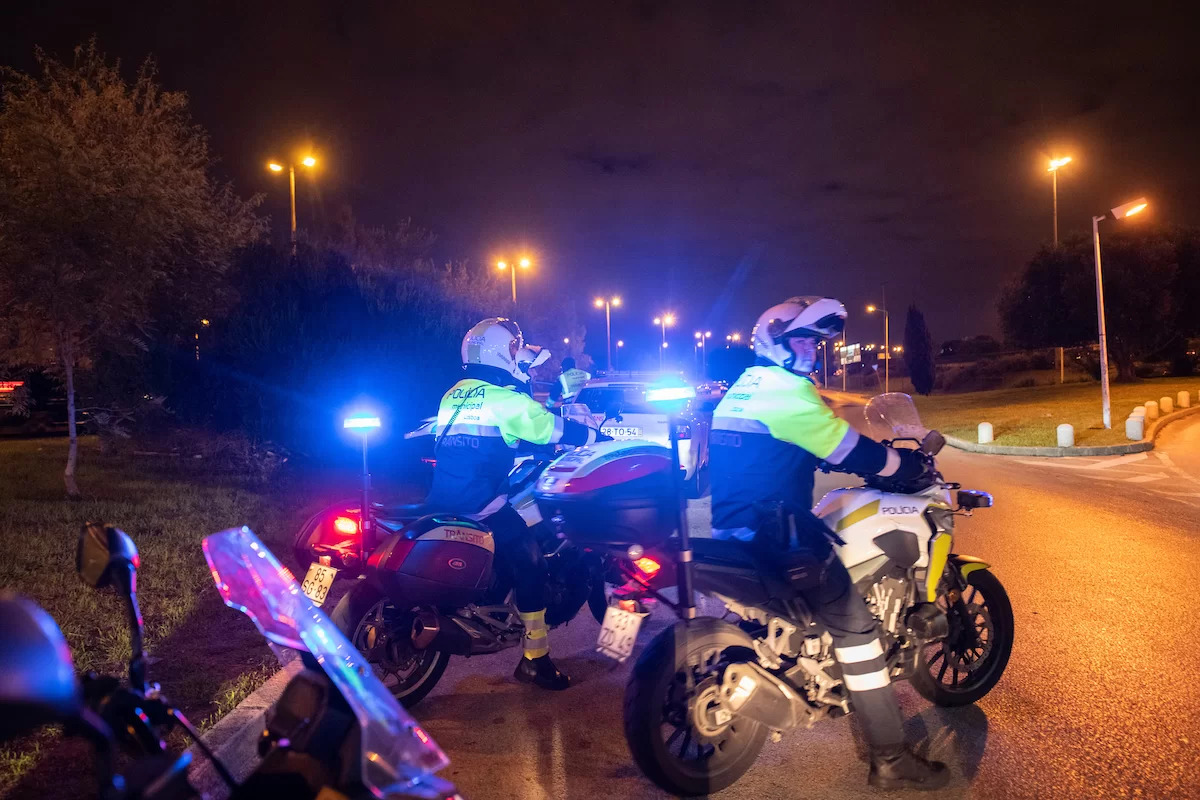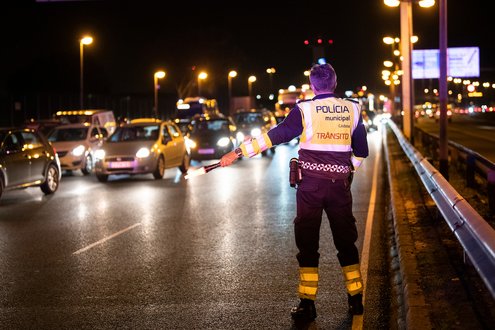Lisbon Municipal Police
All cats are brown at night. Unless the Lisbon Municipal Police are on the ground.
Since August, officers from the Traffic Division of the Lisbon Municipal Police have been policing the 2nd Circular from 8pm to 6am. The road is being resurfaced and road signs replaced and improved. PML is responsible for the safety of construction workers, drivers and citizens in general.
At 7pm, the officers of the Traffic Division of the Lisbon Municipal Police have already prepared the equipment and material needed for the operation they have been assigned: night policing on the 2nd Circular.
They put on reflective vests, put on cuffs and leggings, check out the signaling equipment they have to carry in their vans: cones, lanterns, radios... In between, they drink another coffee, take a drink of water out of the machine, finish the day's conversation, check their watches. A little commotion is duly organized.
It's a quarter to 8pm and you have to leave the Command in Praça de Espanha in the direction of the 2nd Circular. Everything is millimetrically calculated and duly planned. On this much colder night, the meeting point is next to the fuel pumps at Lisbon Airport.
Commissioner David Vieira, deputy commander of the PML's Traffic Division and responsible for the security operation, fires off the latest orders in all directions. The men are fast and diligent. Motorcycles, vans and patrol cars leave Cardeal Saraiva in the direction of the 2nd Circular. "This policing is to ensure the safety of the company's workers who are setting up the signs, as well as the safety of all road users," explains the Commissioner, who has been with PML for about a year.
But for the mission to be a success, the operation has to be carefully planned, both strategically and in terms of execution.
From a strategic point of view, the Commissioner explains, what the Commander outlines is carried out. To do this, "it's necessary to take some steps, namely to hold preparatory meetings with the Lisbon City Council and the construction company".
The aim is to identify the route to be policed, the cuts to be made, the procedures to be carried out, the number of men to be deployed and the vehicle resources needed to carry out the mission. Then it's off to the field: "It's extremely important to reconnoiter the site," he stresses. "Because the characteristics of the road can change from one moment to the next. The appearance of a single pothole can jeopardize all the planning."
Once everything has been properly checked and defined, a Mission Order is drawn up so that the agents understand what the commander wants them to do. That's what PML is going to show us tonight.
Final preparations
At 8 p.m., all the officers assigned to night policing on the 2nd Circular are concentrated near the gas station close to the airport.
In a rapid work meeting, the Commissioner gives instructions for the night, indicating who is going where, which accesses should be cut off and guarded, and which alternatives should be communicated to drivers: "... alternative to Estrada da Luz, head towards Avenida Lusíada, towards IP7, take detour 2...".
It is imperative that no motorist enters one of the sealed accesses, at the risk of compromising the operation, endangering the lives of the construction workers and the police themselves: "Today we are going to make 12 cuts, so that the 2nd Circular is closed, there are no cars on it, while the employees of the company that was awarded the contract set up the signs and the bevel, which is a road cut in the right conditions so that road traffic can then be resumed," reveals the Commissioner.
Once demobilized, the agents move off in various directions to carry out the instructions they have received. Everything has to be ready in just over an hour.
We went with Agent Melo to Santa Iria de Azóia, where we waited for the person in charge of the works to start slowing down and stopping traffic on the A1 in a north-south direction.
A lot of calm and understanding
In Santa Iria, the patrol cars are placed side by side. In order for the construction workers to be able to start work safely, the officers have to resort to slowing down techniques, with a gradual reduction in speed from 80 km to 60, 40, 20 up to 0 km, with a temporary stop and cut.
The operation takes about 15 minutes until the point set for the total stoppage of traffic is reached: "Our job here consists of braking. A situation in which we slow down traffic in order to create a safety cushion" until traffic comes to a complete stop, explains Officer Melo. "The main concerns are always people's safety and our own. To ensure that traffic flows as smoothly as possible, despite the inconvenience we are unfortunately already causing drivers."
On the stretch of road where the work will take place, the agents will cut off all the marked access routes, some briefly, others permanently, and traffic will be closely monitored, lest someone wants to force their way into the forbidden zone.
It's a complex and careful job, which requires attention and patience, admits Commissioner David Vieira. "There are two stages to this policing, namely setting up these cuts and then a second stage, which is dismantling them. And in between is the work itself, which isn't really our responsibility, but we have to make sure that while the work is going on until 6am no one enters the 2nd Circular. So, as well as making the cuts, we have to make sure that no one opens them, and that no one breaks through what has been outlined in the operations order."
Between the bevel, the cuts and the cones, however, there are always a few more daring drivers, says Officer Melo, shrugging his shoulders. "Normally most people react well, but some get offended, they think this is deliberate." This requires a lot of calm and understanding: "We understand that it's only in the heat of the situation, that they're angry, upset". The biggest problem, she stresses, is when radicals come along and are so angry that they even advance towards the agents: "Some people find it hard to understand that we're there to keep them safe. And we've had one or two cases of drivers who, even though they see us, move their vehicles towards us to ask for explanations. We have to explain, calm them down, until they understand that it's for everyone's safety that this policing is being done."
However, the PML stresses the collaboration and citizenship of drivers, more than the occasional stressed-out driver.
Patience will be key, and everyone will need it until 5am, when the workers start removing the machines and equipment from the road and the police can rest.
- On average, 110,000 vehicles pass daily on the 2nd Circular, the urban road with the most traffic in the country;
- The upgrading of the road aims to improve safety and traffic conditions for vehicles;
- The works will continue to be carried out at night to limit possible and probable constraints for drivers, until mid-2021.
Mission, Vision, Strategy
The Lisbon Municipal Police is a service within the structure of the Lisbon municipality, equivalent to a Municipal Directorate.
Its mission is to serve citizens and ensure safety, monitoring compliance with all laws and regulations within the scope of the municipality's legal powers and duties, promoting active citizenship and participation in safety for the well-being of citizens and quality of life in the city.
Its values are based on prevention, oriented towards interculturalism, in and with local communities, with a philosophy of bringing police and citizens closer together, at the forefront of information technology and underpinned by credibility, respect and trust in citizens.







